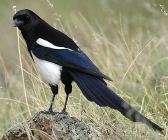Bible Study, Part Three: A World Restored
 No tour of the environmental texts in the Bible would be complete without a visit to Isaiah’s Peaceable Kingdom; and since we’d already seen that Kingdom promised in Hosea 2:14-23, there could hardly be any question about what came next.
No tour of the environmental texts in the Bible would be complete without a visit to Isaiah’s Peaceable Kingdom; and since we’d already seen that Kingdom promised in Hosea 2:14-23, there could hardly be any question about what came next.
Hosea 2 gave us the bridal possession — God leading the faithful as His collective Bride down the aisle of the church of the wilderness — that ultimately leads into the world remade. Isaiah 11 gives us a description of what that world remade will look like when we get there.
And so, on the third day of our Bible study, Isaiah 11 was what we took up.
And the wolf shall dwell with the lamb,
the leopard lie down with the kid [young goat],
the calf, the young lion, and the fattened [sheep] together:
a little child shall lead them.The cow and the bear shall graze,
their young lie down together,
the lion eat straw like the ox.The nursing child shall play by the hole of the asp,
the weaned child put his hand in the viper’s den.They shall not hurt nor destroy in all My holy mountain,
for the Earth shall be full of the knowledge of YHWH
as the waters cover the sea. (vv. 6-9)
Here are the fruits of the covenant that Hosea promised, that would be made between humans and the animal nations. It’s a vision of the restoration of the situation in Genesis 1:29-30, where God gave humanity “dominion” in the context of a world where all humans and animals would be vegetarian. It’s a vision of entire and perfect shâlôm (reconciliation and peace), not just among humans, but throughout all the world.
We need not take the specifics of this vision too seriously. What matters here is the end to all strife and killing among all beings with minds and feelings, and its replacement by a universal gentleness and reconciliation in which a newly innocent humanity takes a leadership rôle. It doesn’t depend on the lion specifically eating straw. (Perhaps the lion would actually eat a soy-and-algae product to get the nutrition it needed? If humans play a leadership rôle, they are presumably permitted to employ human skills in a Spirit-led way to make the basic vision work for all creatures.)
Friend Edward Hicks’s vision of the Peaceable Kingdom — Hicks, The Peaceable Kingdom of the Branch (1822-25). The border of this painting carries a paraphrase of Isaiah 11:6-9.
What matters also is the cause to which this transformation is ascribed: it will happen because the Earth shall be full of the knowledge of YHWH as the waters cover the sea. In other words, this will be brought about by a phenomenon similar to that by which a kind and sensitive person tames animals here in our present day — only much, much more so. The Desert Fathers of Egypt, the Celtic saints of Ireland and England, and Francis of Assisi, all took time to demonstrate that this prophecy is more than just hot air, by taming normally untamable wild predators with the power of their compassion.
It was interesting to me that this vision did not sit well with many of the Friends in our Bible study group. They protested that it could not possibly mean what it said; surely it must be a metaphor that actually refers only to reconcilation among humans!
In the privacy of my heart, I found myself wondering whether this resistance to the inclusion of the creatures alongside humanity, is related in some way to another resistance: some Friends’ resistance to the idea that the work of AFSC and FCNL should address the needs of the creatures alongside those of humanity.
I don’t know the answer to that one, folks; it’s only a question in my mind, and no more. But it gave me a clearer sense of what I might be called to address in my speech to the yearly meeting that coming Saturday night.






Reader Comments